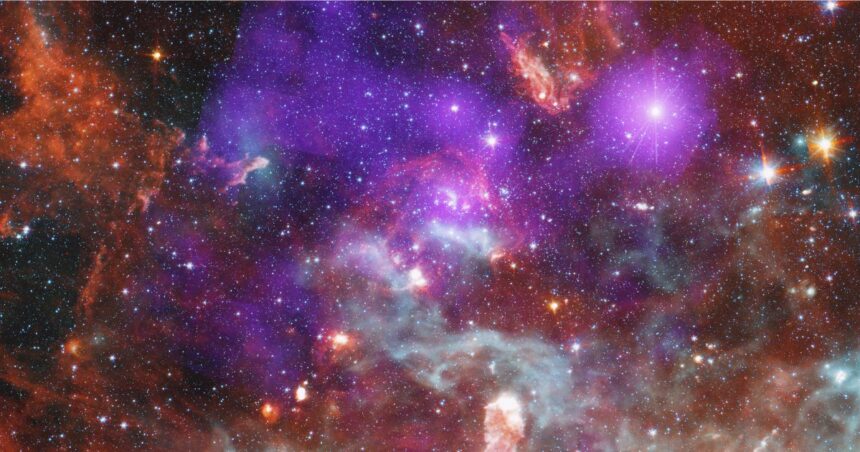NASA’s Chandra X-ray Observatory, in collaboration with the now-retired Spitzer Space Telescope, has uncovered regions termed “danger zones” surrounding young stars. These high-radiation zones hinder the formation of planets by eroding crucial material in the stars’ vicinity.
Using advanced imaging techniques, astronomers identified how intense X-ray and ultraviolet radiation disrupts planet-forming disks. This finding sheds light on early planetary system formation and the specific environmental risks in young star clusters.
Chandra X-Ray and the Search for ‘Danger Zones’
The Chandra X-ray Observatory, NASA’s flagship space-based X-ray telescope, offers unparalleled insights into high-energy processes in space. Launched in 1999, Chandra detects X-rays from some of the universe’s hottest regions, from exploding stars to black holes. Its ability to detect faint X-ray emissions enables astronomers to study phenomena in distant star clusters.
The Role of the Spitzer Space Telescope
Before its retirement in 2020, NASA’s Spitzer Space Telescope provided infrared imaging that complemented Chandra’s X-ray data. Spitzer’s observations helped visualize the cooler dust and gas in stellar environments, offering a comprehensive view of star-forming regions. Together, Spitzer and Chandra created a detailed mosaic of the star cluster Cygnus OB2, unveiling unique insights into the stellar life cycle.
How Do Stars and Planets Form Together?
Stars and planets emerge from protoplanetary disks—dense, rotating clouds of gas and dust that surround young stars. Over millions of years, particles in these disks coalesce to form planets. However, intense radiation from massive stars in star clusters can disrupt this process.

The Impact of High-Energy Radiation on Protoplanetary Disks
In star clusters like Cygnus OB2, high-energy ultraviolet and X-ray radiation from young, massive stars can heat up the material in these protoplanetary disks. This heating triggers a process called photoevaporation, where disk material is pushed away, gradually thinning and even erasing the disk, which can terminate planetary formation prematurely.
Read More: Catch of the Century: SpaceX’s Starship Booster Makes History
What is Cygnus OB2 and Why is it Important?
Located 4,600 light-years from Earth, Cygnus OB2 is one of the nearest large star clusters. Housing thousands of stars of varying mass, this cluster provides a natural laboratory to study the impact of intense radiation on planetary formation. The latest Chandra and Spitzer observations offer a rare glimpse into how young stars’ intense radiation alters the structure of protoplanetary disks.
Through long-term observation, the team stitched together images from Chandra and Spitzer to build a composite of Cygnus OB2. Chandra’s X-ray data revealed young stars and the diffuse, high-energy glow between them, while Spitzer’s infrared data highlighted the cooler gas and dust. Together, these images formed an inventory of stars, allowing astronomers to track the impact of radiation on their surrounding disks.
In examining Cygnus OB2, researchers identified regions with severe X-ray and ultraviolet radiation, which they dubbed “danger zones” for planetary formation. These zones are especially problematic for stars with large protoplanetary disks, as the intense radiation depletes these disks faster, limiting the material available for planet formation.
How Radiation Levels Vary Across Cygnus OB2
The team found significant variation in disk survival rates depending on a star’s location within the cluster. Stars in denser regions, closer to massive stars, lose their disks more rapidly than stars situated in less crowded areas. This radiation-driven loss creates substantial obstacles for planet formation near high-energy sources.
The Process of Photoevaporation in Planetary Disks
What is Photoevaporation?
Photoevaporation occurs when high-energy light from nearby stars heats the material in a protoplanetary disk. This heat causes the material to escape in streams known as disk winds, thinning the disk over time.
How Long Do Protoplanetary Disks Last?
For average-mass stars like our Sun, protoplanetary disks can last up to 10 million years. However, in high-radiation clusters like Cygnus OB2, intense radiation accelerates this process, leading to faster disk depletion and, in turn, curbing the chances of planetary formation.
The Influence of High-Energy Radiation on Planetary Formation
As high-energy radiation evaporates material in the disk, it also creates radiation pressure that pushes this material outward. Combined, photoevaporation and radiation pressure create fierce disk winds that strip protoplanetary disks, limiting the chances of planet formation.
Researchers noted a stark contrast in disk presence between stars located in different regions of Cygnus OB2. In densely packed regions with intense radiation, only 1% of stars retained their disks. By comparison, less densely packed regions showed disk presence in about 40% of stars.
How Do Disk Winds Impact X-Ray Emissions?
Complementing the “danger zone” study, another team used Chandra to investigate how disk winds interact within the cluster. When these winds collide, they heat up, emitting additional X-rays. This secondary X-ray emission provides further evidence of the disruptive environment in Cygnus OB2.
Different Energy Levels in X-Ray Emissions
High-energy emissions result from the interaction between powerful disk winds, while lower-energy X-rays emerge from disk winds hitting cooler gas. These findings suggest that Cygnus OB2 is a complex environment with multiple high-energy processes impacting young stars.
Editor’s Recommendations
- Euclid Space Telescope Reveals the 1% of Universe Map From Great Cosmic Atlas
- Hubble Telescope Captures Breathtaking ‘Stellar Volcano’ Eruption
- 1st Triple Black Hole System Found by Chance, But It Challenges the Coventional Black Hole Formation Theories
- Universe Shakedown: What Really Happens When Black Holes Merge?





